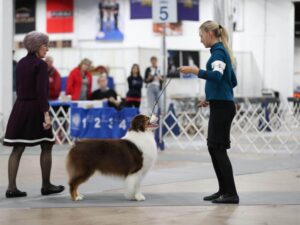
Interview with Savanna Michalak – 2023 Kennel Club of Philadelphia Best Junior Handler
Interview with Savanna Michalak, 2023 KCP Best Junior Handler. Discover her journey, triumph, and aspirations in this inspiring feature.

Home » Dog Breeds » Australian Shepherd Dog Breed




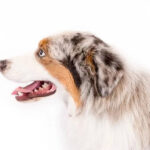

The Australian Shepherd, frequently referred to as the “Aussie,” has a name that might suggest an Australian origin, but it was actually primarily developed in the United States. This breed is renowned for its vibrant appearance, keen intelligence, and boundless energy. Recognized as a versatile herding dog, the Aussie is not only an outstanding worker but also a beloved companion.
Herding
18-23 Inches
40-65 Pounds
12-15 Years
| Country of Origin | United States |
|---|---|
| Bred For | Herding, Guarding, Companionship |
| Known For | Intelligence, Trainability, Loyalty |
| Popularity | High |
| Temperament | Intelligent, Exuberant, Good-Natured |
| Activities | Herding, Tracking, Running, Hiking, Farm Dog, Conformation Shows, Dog Sports |
Contrary to its name, the Australian Shepherd did not originate Down Under. Its roots can be traced back to the Basque region of the Pyrenees Mountains between Spain and France, although the modern breed’s development took place in the United States.
In the early 1800s, Basque shepherds began to emigrate to Australia in search of greener pastures and job opportunities. They brought with them their trusted sheepdogs, which had evolved over centuries to excel in the challenging mountain terrain of the Pyrenees. In Australia, these shepherds and their dogs were exposed to a new range of sheep herding tasks, and over time, the dogs may have interbred with local dogs, further refining their herding capabilities.
By the late 1800s and early 1900s, many of these Basque shepherds, along with British settlers, moved to the United States, especially to the West Coast. They brought their unique dogs with them, and American ranchers were deeply impressed by the dogs’ herding prowess, mistakenly assuming the breed had Australian origins due to its recent migration pattern. Hence, the name “Australian Shepherd” took hold.
The breed’s capabilities, however, were not restricted to herding. In the American West, they quickly gained popularity in rodeos and at horse shows, and even on TV programs, gaining a reputation as highly trainable, smart, and versatile performers.
Over the years, different Breed Standards for the Australian Shepherd emerged. The American Kennel Club (AKC) officially recognized the breed in 1993, although it had been popular in the country long before this formal recognition. Other major canine organizations, like the Fédération Cynologique Internationale (FCI) and The Royal Kennel Club (UK), have also recognized the breed, emphasizing its stature and significance in the canine world at-large.
Throughout its history, the Australian Shepherd has remained a beautiful symbol of adaptability, intelligence, and hard work. From the rugged mountains of Europe to the tough Australian territories to the sprawling ranches of the American West, the Aussie has always been a trusted companion and invaluable worker, embodying the spirit of frontier life.
Adult male Australian Shepherds typically stand between 20 and 23 inches at the shoulder, while mature females measure slightly smaller, ranging from 18 to 21 inches tall.
In terms of weight, males generally weigh between 50 and 65 pounds, while females typically weigh between 40 and 55 pounds.
The Australian Shepherd is slightly longer than it is tall, giving it a somewhat rectangular yet balanced profile. This proportion supports the breed’s agile and athletic nature, allowing for quick direction changes; a trait that’s invaluable in a herding dog. The Aussie’s substance is solid without appearing stocky, maintaining an air of agility and speed.
Texture: The Australian Shepherd’s coat is of medium texture, neither coarse nor fine, and straight to slightly wavy in texture. The breed has a double coat. The outer coat is resistant to rain whereas the undercoat varies in quantity, depending on the climate. The coat is typically more profuse in males than in females, especially on the mane and frill.
| Standard Color | |
|---|---|
| Black | ee |
| Blue Merle | ee |
| Red | ee |
| Red Merle | ee |
| Standard Marking | |
|---|---|
| White Markings | ee |
| Tan Points | ee |
| White Markings, Tan Points | ee |
A Note About Color: White is acceptable as a blaze on the head and on the neck, chest, legs, underside of the muzzle, and up to four inches on the underpart as measured from the elbow. White on the head should not predominate, and the eyes are to be fully surrounded by color and pigment. White anywhere other than described is unacceptable.
The Australian Shepherd’s tail is another distinctive feature of the breed. Traditionally, it is straight and naturally short, often referred to as a “bobtail.” The tail’s length can vary, but it is typically not longer than four inches. Aussies that are born with longer tails often have them docked when they are puppies, although this practice varies based on regional standards and personal preferences.
In recent years, there’s been a trend towards leaving the tail undocked in regions where docking is not required or permitted. When left natural, the tail is moderately long and slightly curved, carried in a relaxed manner when the dog is at rest. In motion or when alert, the tail should be raised but should not curl over the back.
It’s essential to note that whether docked or undocked, the tail should not be the determining factor in the Aussie’s overall quality.
Owning an Australian Shepherd is a rewarding experience, given the breed’s intelligence, loyalty, and energy levels. Often chosen for its herding abilities and as a family companion, the Aussie is known to be an exceptionally versatile dog. However, as with any breed, it’s essential to understand its specific needs and characteristics to ensure a harmonious relationship between the dog and its family members.
The Australian Shepherd is generally a healthy and robust breed, but, like all breeds and mixed breeds, these dogs aren’t immune to certain health conditions. Regular vet check-ups, a balanced diet, and a good exercise regimen can help to maintain an Aussie’s overall well-being.
Lifespan: The average life expectancy of an Australian Shepherd ranges from 12 to 15 years. This lifespan can be influenced by various factors, including genetics, diet, exercise, and regular veterinary care.
Australian Shepherds, though generally robust, can be predisposed to certain health concerns. Awareness of these can guide owners towards early detection, timely treatment, and prevention when possible:
Regular veterinary check-ups are crucial for early detection of these and other potential health issues. Owners should maintain an open dialogue with their veterinarian about any unusual symptoms or behaviors that are observe in the Aussie.
In addition to understanding these potential health risks, routine preventive care, such as vaccinations, heartworm prevention, and flea and tick control, are crucial for maintaining an Australian Shepherd’s overall health.
The Australian Shepherd is a breed marked by a vibrant spirit, great intelligence, and supreme adaptability. The breed’s dynamic personality always shines through, making it a favorite among many dog enthusiasts. For those considering an Aussie as a companion, there are several aspects of the breed’s temperament to understand.
Being a breed bursting with energy and intelligence, the Australian Shepherd can sometimes be overwhelming for novice dog owners. The breed’s drive to work, play, and please is commendable, but it also means these dogs require owners who are ready to channel that energy positively. Their intelligent nature means Aussies are quick learners, but it also signifies a need for mental stimulation and engagement.
One of the endearing qualities of the Australian Shepherd is its sensitivity. These dogs form strong bonds with their families and can be deeply attuned to their owner’s emotions. This sensitivity, paired with their eagerness to please, means the Aussie responds best to positive reinforcement during training.
If you’re someone who is away from home often, it’s essential to know that Australian Shepherds don’t particularly enjoy being left alone for extended periods. Their preference for company can manifest in seeking out human companionship or bonding with other pets. Without engagement, they can become bored, which might lead to undesirable behaviors.
A common concern for potential dog owners is how the breed interacts with others. Australian Shepherds, with their social nature, generally get along well with other dogs, especially if they’ve been introduced to canine companionship early on. This sociability extends to children as well. The breed’s playful demeanor resonates with kids, but families should be aware of the Aussie’s herding instincts, which might lead to nipping at the heels in an attempt to “herd.” With young children, supervision is always a good idea to ensure safe interactions.
While Aussies are friendly and loving with familiar faces, they can be a bit reserved when meeting strangers. However, this doesn’t translate to aggression. With proper introductions, and given time, they can warm up to new people quite quickly. Their alertness, paired with their reserved nature, makes them excellent watchdogs, always keen to alert their family to unfamiliar sounds or visitors.
Nourishing an Australian Shepherd adequately plays a pivotal role in ensuring its health, longevity, and overall well-being. As an active and energetic breed, the Aussie’s dietary needs can be a bit higher than some other breeds, so finding the right balance is key.
When considering the nutritional needs of an Australian Shepherd puppy, it’s essential to provide a diet specifically formulated for growth. Puppies have a fast metabolism and require more calories and nutrients than adult dogs. It’s vital to feed them several small meals throughout the day to support their growing bodies and energy requirements. As puppies transition to adulthood, the frequency of meals and the calorie intake will gradually change.
Adult Australian Shepherds, given their high energy levels, also have robust nutritional requirements. They benefit from high-quality dog food, whether it’s commercially manufactured or prepared at home following expert veterinary advice. Caution should always be given to the quantity of food, ensuring it aligns with a dog’s weight, age, and activity level. Overfeeding can lead to obesity, a problem that can be detrimental to the breed, given its need for daily activity.
The amount of food an Australian Shepherd requires can vary based on several factors, including its size, age, metabolism, and activity level. Typically, a standard-sized adult Aussie might consume about 1.5 to 2.5 cups of high-quality dry food daily, divided into two meals. However, this is a generalized guideline, and it’s always best to consult with a veterinarian or pet nutritionist to determine the optimal amount and type of food for your individual dog.
It’s also worth noting that Australian Shepherds can have a surprisingly hearty appetite. This love for food, combined with their intelligent and sometimes manipulative nature, means they might try to coax extra treats out of their owners. While treats can be an essential aid in training, they should be given only in moderation.
Training an Australian Shepherd is a rewarding experience, but it does require patience, consistency, and understanding of the breed’s unique temperament. The Aussie’s intelligence and agility aren’t just suited for herding; these qualities also make these dogs standout performers in Obedience and other dog sports.
Australian Shepherds are innately driven by a desire to work alongside their human companions. This trait, while advantageous, means they crave tasks and activities to engage their minds and bodies. Without adequate mental stimulation, they may resort to creating their own “jobs,” which might not always align with a peaceful household, such as digging up the garden or chewing on furniture.
When it comes to ease of training, the Australian Shepherd is often a step ahead. The breed’s intelligence means it typically picks up new commands quickly. However, this also means the Aussie can easily pick up bad habits if not trained properly. Positive reinforcement methods, including treats, praise, and play, are usually the most effective training tools for this breed. Aussies respond best to an upbeat and varied training routine that challenges their intellect.
Barking can be an issue with some Australian Shepherds. The breed’s herding background and watchdog tendencies mean they can be vocal, alerting their owners to anything they deem unusual or interesting. While this can be advantageous for those seeking an alert dog, it can become problematic if not addressed early on. Teaching a “quiet” command can be beneficial for the duration of the relationship.
Aussies are also known to have a certain degree of wanderlust. Their curiosity and energy can drive them to explore, and they might chase after animals due to their herding instinct. Ensuring a secure environment, like a fenced yard, and incorporating recall training can be crucial for their safety.
Lastly, the Australian CShepherd’s predation drive, stemming from its herding origins, can manifest in chasing smaller animals or even “herding” moving objects, like bikes or cars. While this behavior is instinctual, it can be managed and redirected with consistent training and socialization from a young age.
The Australian Shepherd is not just a bundle of energy; it’s a tornado of enthusiasm, intelligence, and drive. Understanding and addressing its exercise needs is paramount to ensuring its physical health and mental well-being.
| Energy Level | High |
|---|---|
| Exercise Requirements | 2 Hours/Day (Minimum), Daily Walks, Vigorous Running, Regular Exercise, Playing with Another Dog, Mental Stimulation |
Bred as a herding dog, the Australian Shepherd possesses an innate desire to work, move, and be constantly engaged. This background informs much of its exercise needs. Merely letting an Aussie out in the backyard isn’t enough; this breed needs structured activities, tasks, and challenges to keep its agile mind and body engaged.
Walking is fundamental, and a brisk walk twice a day can help to channel some of the Aussie’s energy. However, walks alone aren’t sufficient for this dynamic breed. Incorporating tasks like fetching, agility drills, and even herding exercises (if feasible) can provide both physical exertion and mental stimulation. These activities will not only keep these dogs fit, they will also fortify the bond between the dog and its favorite people.
Energy level aside, Australian Shepherds also have an inherent intensity in everything they do. Whether they’re playing fetch, chasing a toy, or participating in dog sports, they do it with full zeal. Recognizing and appreciating this intensity is crucial, as is ensuring they have the appropriate outlets to express it.
Playfulness is another defining trait of the Australian Shepherd. This breed revels in games, interactive toys, and any opportunity to engage with its human companions. The Aussie’s playful demeanor can be an excellent way to introduce varied activities that cater to both the physical and mental exercise needs of this canine athlete.
The Australian Shepherd, with its striking coat, requires regular grooming to maintain its health and appearance. While the breed may not need as meticulous grooming as some others, there are key areas and practices an owner should be familiar with to ensure their Aussie looks and feels its best.
| Coat Type | Straight to Wavy, Medium Length, Weather-Resistant |
|---|---|
| Grooming Requirements | Weekly Brushing, Occasional Bathing, Routine Ear Cleaning, Periodic Nail Trimming, Regular Tooth Brushing |
The Australian Shepherd boasts a medium-length coat that can be wavy or straight, giving them a distinctively lush appearance. This beautiful coat, however, can become a magnet for dirt, debris, and loose hairs. Regular brushing, at least two to three times a week, is essential to prevent tangles and matting, especially in the coat’s denser areas such as behind the ears and under the legs. During shedding seasons, typically in the spring and fall, daily brushing can be advantageous in managing the dead hair.
Shedding is a natural part of the Australian Shepherd’s life. While the breed isn’t the heaviest of shedders, these dogs do shed year-round with noticeable upticks during the aforementioned seasons. Investing in a quality de-shedding tool and a good pin brush will aid in keeping the Aussie’s coat manageable and reducing the amount of hair around the home.
Bathing an Aussie isn’t a frequent necessity. Due to the natural oils in the dog’s coat, overbathing can lead to dry skin and a dull appearance. Bathing once every couple of months, or when the dog is particularly dirty, is usually sufficient. It’s essential to use a dog-specific shampoo that’s gentle on the Aussie’s skin and coat.
Aside from coat care, other grooming essentials include regular nail trimming, ear cleaning, and dental care. Keeping an Australian Shepherd’s nails at an appropriate length prevents overgrowth and related issues, while regular ear cleaning can help to prevent infections. Dental care, through brushing or dental chews, is vital to ensure good oral health and prevent potential complications.
The experience of living with an Australian Shepherd is both demanding and rewarding. With their vivacious energy and keen intelligence, Aussies weave a rich tapestry of joy and challenges into the lives of their people.
In urban environments like apartments, Australian Shepherds can adjust, but it’s essential to understand the breed’s inherent need for space and stimulation. While Aussies can live in smaller spaces, the proximity to parks or open areas for exercise becomes paramount. Their abundant energy, a legacy of their herding origins, demands ample physical and mental outlets, especially if confined to smaller living quarters.
The coat of an Australian Shepherd, dense and double-layered, speaks to the breed’s adaptability to varying weather conditions. In cold climates, this coat serves the Aussie well, offering protection against chilly temperatures. However, it’s always wise to be cautious and not expose this dog, or any dog, to the extremes of cold for extended periods. In contrast, during hotter months, while the breed’s coat does offer a shield against the sun, an Aussie should have access to shaded areas, and activities during peak periods of heat should be limited. Cool indoor spots and plenty of water are essential to ensure the dog’s comfort.
Beyond just its physical space requirements, an Australian Shepherd craves a stimulating environment. These dogs thrive when presented with toys or engaged in interactive play, and when they can participate in regular training sessions. Such engagements not only cater to their energy but also prevent the onset of undesirable behaviors that might arise from boredom.
A subtle but significant aspect of living with an Aussie is the breed’s innate herding instinct. This can manifest in attempts to “herd” other pets, children, or even inanimate objects such as cars, bicycles, and other moving vehicles. Being aware of this behavior and channeling it appropriately through training is crucial to prevent any untoward incidents.
In essence, embracing life with an Australian Shepherd is a commitment to understanding and catering to the dog’s various needs, from physical exercise to mental stimulation. Those willing to put in the effort are rewarded with a companionship that’s both deep and delightful.
The sight of an Australian Shepherd puppy, with its curious eyes and boundless energy, is enough to melt anyone’s heart. These puppies, though small, come packed with personality and potential. As they transition from puppies to adult dogs, they carry the legacy of a versatile working breed, capable of extreme loyalty and unwavering labor.
Nurturing an Australian Shepherd puppy is an exercise in patience, understanding, and commitment. From the early weeks to the adolescent months, the puppies’ rapid growth and developing personalities require special attention.
Diet is fundamental. As with any growing dog, the Australian Shepherd puppy benefits greatly from a balanced, nutrient-rich diet. This aids the pup’s rapidly developing bones, muscles, and organs. It’s crucial to provide Aussie puppies with high-quality puppy food, which caters to their specific dietary needs during this growth phase.
Socialization is another pillar of puppy care. Introducing them to various environments, people, and other animals during their formative weeks can help to shape temperament and behavior in adulthood. Positive early experiences help to instill confidence and reduce fearful or aggressive tendencies later in life.
Training, too, must start early. While Australian Shepherds are known for their intelligence and eagerness to please, establishing foundational commands and house rules early on can smoothen their transition to adulthood. This includes basic commands, housebreaking, and leash training.
Physical and mental stimulation cannot be overstated. Their herding instincts and sharp minds necessitate engaging play sessions and problem-solving games. Toys that challenge them or simulate herding activities can be particularly effective.
Health check-ups are an integral aspect of care. Regular visits to the vet ensure Aussie puppies are growing well and are free from common puppy ailments. Vaccinations, deworming, and preventive care during these early months can set the stage for a healthy life.
Lastly, love and patience make all the difference. While Australian Shepherd puppies might occasionally be mischievous or stubborn, understanding that this is a phase of learning and growth can help owners guide them with compassion and loving care.
Australian Shepherds are versatile, athletic, and intelligent, making them well-suited for various activities and dog sports. Here’s a breakdown:
Engaging an Australian Shepherd in these activities not only ensures the dog’s physical well-being, it also provides essential mental stimulation. Additionally, participating in such activities strengthens the bond between dog and handler.
Engaging an Australian Shepherd in these activities not only ensures the dog’s physical well-being, it will also provide essential mental stimulation. Participating in such activities will additionally strengthen the human-canine bond.
The Australian Shepherd is recognized by the world’s leading registries and kennel organizations, which categorize the breed into a specific Group based on its unique characteristics. This breed is recognized worldwide under the following Group designations:
| Organization | Group Designation |
|---|---|
| AKC (American Kennel Club) | Herding |
| UKC (United Kennel Club) | Herding Dog |
| CKC (Canadian Kennel Club) | Herding |
| ANKC (Australian National Kennel Council) | Working Dogs |
| RKC (The Royal Kennel Club) | Pastoral |
| FCI (Fédération Cynologique Internationale) | Group 1: Sheepdogs and Cattledogs Section 1: Sheepdogs |
The ideal Australian Shepherd is described by a Breed Standard that is approved by each of the world’s leading registries and kennel organizations. The Breed Standards for this breed may be found in the following links:
| Organization | Breed Standard |
|---|---|
| American Kennel Club | AKC Australian Shepherd Breed Standard |
| United Kennel Club | UKC Australian Shepherd Breed Standard |
| Canadian Kennel Club | CKC Australian Shepherd Breed Standard |
| Australian National Kennel Council | ANKC Australian Shepherd Breed Standard |
| The Royal Kennel Club | RKC Australian Shepherd Breed Standard |
| Fédération Cynologique Internationale | FCI Australian Shepherd Breed Standard |
Breed clubs play an essential role in promoting and preserving the integrity, health, and welfare of specific breeds. For the Australian Shepherd, numerous clubs have been established around the world to champion the breed’s interests.
In the United States, the United States Australian Shepherd Association (USASA) stands out as the primary official parent club for the Australian Shepherd, recognized by the American Kennel Club (AKC). Founded in 1990, USASA is devoted to promoting the well-being and Breed Standard of the Australian Shepherd. The association provides breeders, owners, and enthusiasts with a wealth of resources, programs, and events specific to this uniquely American breed.
Another significant organization in the States that is dedicated to the breed is the Australian Shepherd Club of America (ASCA). Established in 1957, ASCA not only offers a separate Breed Standard, it also caters to breeders and owners with a myriad of resources, events, and programs tailored to the Australian Shepherd. The club’s core objectives include promoting the breed’s natural herding instinct, emphasizing responsible breeding practices, and educating its members about the breed’s rich history.
Canada boasts the Canadian National Australian Shepherd Association (CNASA), established in 1995. CNASA seeks to represent Australian Shepherd enthusiasts and breeders across Canada. The association conducts events, supports research into breed-specific health issues, and upholds the Breed Standard, ensuring the breed’s heritage is honored throughout Canada.
In the United Kingdom, the Australian Shepherd Club of the UK (ASCUK) is the primary organization for Aussie aficionados. Formed in the late 1980s, ASCUK has played a pivotal role in promoting the Australian Shepherd in the UK, providing a platform for shows, trials, and educational endeavors.
Rescue organizations play a vital role in providing Australian Shepherds in need with a second chance. These groups are dedicated to the rescue, rehabilitation, and rehoming of Australian Shepherds that have been abandoned, neglected, or need a new home due to unforeseen circumstances.
In the US, the Aussie Rescue & Placement Helpline (ASRPH) is dedicated to placing displaced or abandoned Australian Shepherds in safe, loving homes. The organization’s mission includes providing public education on the breed, promoting responsible dog ownership, and assisting owners in keeping their Aussie companions instead of surrendering them.
Canada has organizations like the Australian Shepherd Rescue of Ontario, which focuses on rescuing, rehabilitating, and rehoming Australian Shepherds and Aussie mixes in the Canadian province.
In the United Kingdom, while there might not be a breed-specific Australian Shepherd rescue organization, there are broader rescue groups such as The Dogs Trust and Battersea Dogs & Cats Home that may occasionally have an Australian Shepherd available for adoption.
Yes, Australian Shepherds shed. They possess a double coat, with the outer layer being weather-resistant and the undercoat being soft and dense. The breed typically undergoes a more substantial shedding period once or twice a year, often referred to as “blowing coat,” in which the undercoat is shed.
Australian Shepherds generally have a lifespan of 12 to 15 years. With proper care, a balanced diet, regular exercise, and routine veterinary check-ups, many live long, healthy lives. Like all breeds, they can be prone to specific health risks, so awareness and early detection can contribute to their longevity.
Australian Shepherds are a medium-sized breed. Male Aussies typically stand between 20 and 23 inches tall at the shoulder, while females usually measure 18 to 21 inches. Their weight can range from 40 to 65 pounds for males and 35 to 55 pounds for females.
Yes, Australian Shepherds are incredibly intelligent. Their herding lineage required them to make quick decisions in the field, leading to their renowned problem-solving abilities. This intelligence, combined with their eagerness to please, makes them highly trainable, though it also means they require regular mental stimulation.
No, Australian Shepherds are not considered hypoallergenic. Due to their coat’s shedding nature, they produce dander, which can be a common allergen for many people. Those with allergies should spend time with the breed to gauge their reactions before considering adding an Aussie to the family.
Australian Shepherds are occasionally born with a full-length tail. However, it has been the tradition in some regions to dock their tails when they are puppies, primarily for historical reasons related to the breed’s use as a rough and ready herding dog.
Australian Shepherds are generally good with children, especially when raised with them from a young age. Their playful and protective nature makes them wonderful companions for kids. However, due to their herding instinct, Aussies might attempt to herd small children, so it’s crucial to supervise interactions and provide proper training.
Australian Shepherds are not inherently aggressive, but they do possess a strong herding instinct that can lead to behaviors like nipping at heels or trying to “herd” other animals or even people, especially children. These behaviors, while rooted in the breed’s herding instinct, can sometimes be misinterpreted as aggression. Proper training, socialization from a young age, and understanding the breed’s characteristics and needs are essential to ensure every Aussie becomes a well-behaved and integrated member of the family.

Interview with Savanna Michalak, 2023 KCP Best Junior Handler. Discover her journey, triumph, and aspirations in this inspiring feature.

Valerie & Klayton Yarber, Makya Blake, breeders of Paramount Australian Shepherds, share insights and challenges in the dog show community.

Interview with Monique Gautreaux Hetterscheidt. Insights on Australian Shepherd breeding, showing, and the evolving dog show community.
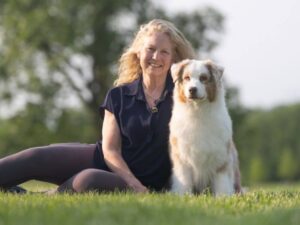
Terri Collins: breeder of quality Australian Shepherds since 2007, shares insights on her breed, health concerns, and the dog show community.
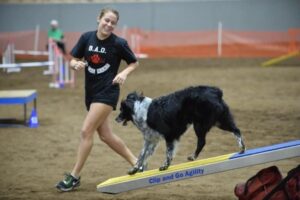
Viveka Rosenberger, an AKC Agility League competitor, talks about how she got started in the sport of Agility, her Agility partner, and more!
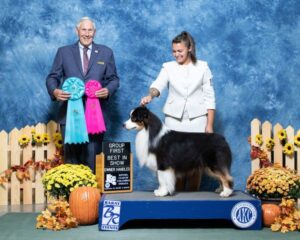
By the time these words are published, the newness of 2023 will have worn off for most people. But as it is, these words

Interview with Anja Cikara-Gocke. Anja shares her thoughts on various topics regarding the Junior Showmanship ring.
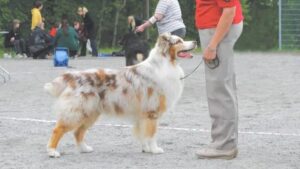
Explore Australian Shepherd tails—unravel bob origins, controversies, and breed perspectives in this captivating article.
The best way to ensure a long and happy relationship with a purebred dog is to purchase one from a responsible breeder. Not sure where to begin?
Contact the National Parent Club’s Breeder Referral Program, which is listed on the AKC Breeder Referral Contacts page.


"*" indicates required fields
Showsight Magazine–the world’s most influential purebred dog publication since 1992. Each issue reaches a global audience dedicated to preserving the history and health of purpose bred dogs. Filled with award-winning editorial focused on news and insights from the dog show community, top breeders, handlers, AKC Judges, and more!